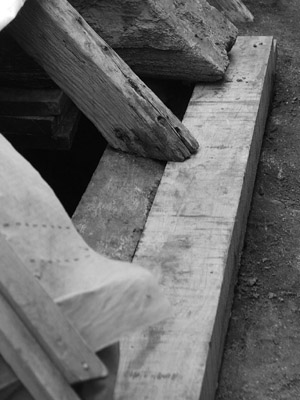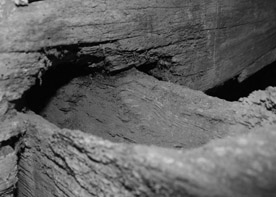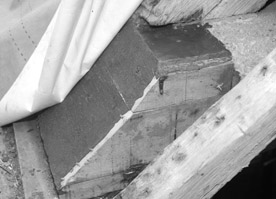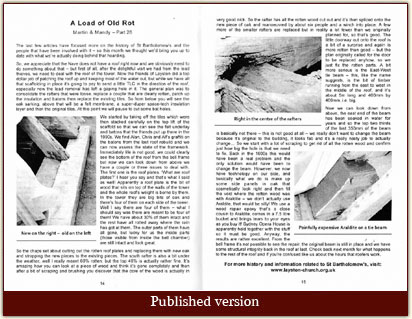Mandy & Martin

The last few articles have focused more on the history of St Bartholomew’s and the people that have been involved with it - so this month we thought we’d bring you up to date with what we’re actually doing behind that hoarding.
So, we appreciate that the Nave does not have a roof right now and we obviously need to do something about that - but first of all, after the delightful visit we had from the lead thieves, we need to deal with the roof of the tower. Now the friends of Layston did a top dollar job of patching the roof up and keeping most of the water out, but while we have all that scaffolding in place it’s going to pay to send a little TLC in the direction of the roof, especially now the lead removal has left a gaping hole in it. The general plan was to consolidate the rafters that were loose, replace a couple that are clearly rotten, patch up the insulation and batons then replace the existing tiles. So from below you will see the oak sarking, above that there will be a felt membrane, a super duper space tech insulation layer and then the original tiles. At this point we will pause to cut some bat holes.

We started by taking off the tiles which were then stacked carefully on the top lift of the scaffold so that we can see the felt underlay and batons that the friends put up there in the 1990’s. We find Alan, Chris and Alf’s graffiti on the batons from the last roof rebuild and we can now assess the state of the framework. Immediately life is not good, we could clearly see the bottom of the roof from the bell frame but now we can look down from above we have a couple or three issues to deal with. The first one is the roof plates. ‘What are roof plates?’ I hear you say and that’s what I said as well! Apparently a roof plate is the bit of wood that sits on top of the walls of the tower and the whole roofs’ weight is borne by them. In the tower they are big bits of oak and there’s four of them on each side of the tower. Well I say there are four of them - what I should say was there are meant to be four of them! We have about 30% of them intact and the rest have all rotted away where the rain has got at them. The outer parts of them have all gone but lucky for us the inside parts (those visible from inside the bell chamber) are still intact and look great.
So the chaps set about cutting out the rotten roof plates and replacing them with new oak and strapping the new pieces to the existing pieces. The south rafter is also a bit under the weather, well I really meant 60% rotten but the top 40% is actually rather fine.  It’s amazing how you can look at a piece of wood and think it’s gone completely and then after a bit of scraping and brushing you discover that the core of the wood is actually in very good nick. So the rafter has all the rotten wood cut out and it’s then spliced onto the new piece of oak and maneuvered by about six people and a winch into place. A few more of the smaller rafters are replaced but in reality a lot fewer than we originally planned for, so that’s good. The little doorway out onto the roof is a bit of a surprise and again is more rotten than good - but the plan originally called for the door to be replaced anyhow, so we just fix the rotten parts. A bit more serious is the East-West tie beam - this, like the name suggests, is the bit of timber running from the east to west in the middle of the roof, and it’s about 5m long and 400mm by 400mm i.e. big.
It’s amazing how you can look at a piece of wood and think it’s gone completely and then after a bit of scraping and brushing you discover that the core of the wood is actually in very good nick. So the rafter has all the rotten wood cut out and it’s then spliced onto the new piece of oak and maneuvered by about six people and a winch into place. A few more of the smaller rafters are replaced but in reality a lot fewer than we originally planned for, so that’s good. The little doorway out onto the roof is a bit of a surprise and again is more rotten than good - but the plan originally called for the door to be replaced anyhow, so we just fix the rotten parts. A bit more serious is the East-West tie beam - this, like the name suggests, is the bit of timber running from the east to west in the middle of the roof, and it’s about 5m long and 400mm by 400mm i.e. big.

Now we can look down from above the east end of the beam has been soaked in water for years and so the top two thirds of the last 350mm of the beam is basically not there - this is not good at all - we really don’t want to change the beam because it’s original to the building, it looks fab and it’s a really nasty job to actually change… So we start with a lot of scraping to get rid of all the rotten wood and just confirm just how big the hole is that we need to fix. Back in the 1600’s this would have been a real problem and the only solution would have been to change the beam. However, we now have technology on our side, and basically what we do is make up some side panels in oak that cosmetically look right and then fill the void where the rotten wood was with Araldite - we don’t actually use Araldite that would be silly! We use a wood repair epoxy that’s a close cousin to Araldite, comes in a 7.5 litre bucket and bri
 ngs tears to your eyes as you buy it! Sydney Opera House is apparently held together with the stuff so it must be good. Anyway the results are rather excellent, from the bell frame it’s not possible to see the repair, the original beam is still in place and we have some structural integrity back in the roof at last. Check back next month for what happens to the rest of the roof and if you’re confused like us about the hours that roofers work.
ngs tears to your eyes as you buy it! Sydney Opera House is apparently held together with the stuff so it must be good. Anyway the results are rather excellent, from the bell frame it’s not possible to see the repair, the original beam is still in place and we have some structural integrity back in the roof at last. Check back next month for what happens to the rest of the roof and if you’re confused like us about the hours that roofers work.
his is a line from one of Martin's favourite songs – he makes me listen to all sorts of weird music so I'm sitting here with noise cancelling headphones on trying to block it out so I can concentrate! Anyway, the link here is that we do have a Captain in our records although, sadly, not a Pirate, but then you can't have everything in life! However he was still a very interesting character in the history of the church. Many people of that time would not have ventured much further than the next village, but our Captain sailed all round the world, lived in London, but is recorded in nice neat writing as having been buried in the Nave of Layston church in 1749.
 |
|
 |
